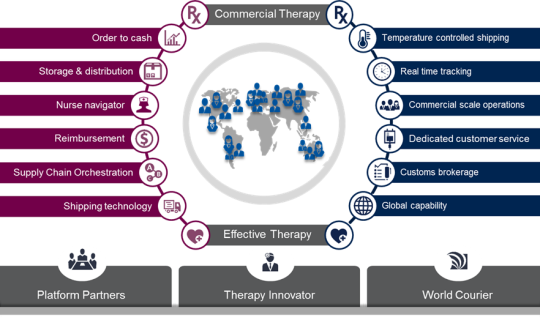Article: Scaling to Commercial Viability for Cell and Gene Therapies
By World Courier
A key factor in scaling advanced therapies into commercially viable products is in learning from the past. This month saw Montreal host the ISCT Annual Conference where I had the pleasure of chairing a session looking at lessons learned from the growth and commercialization of Provenge, MACI, and Strimvellis.
A key message was that the evolution of cell and gene therapies into commercially available treatments is a reality. However, for this progression to continue, therapy developers must embed, early in their development process, logistics platforms that can scale from clinical operations into viable, commercial scale, delivery systems.

Fig 1
Scale up/out
Fig 1 shows the growth of shipments originating from North America and can be used as proxy to illustrate how a therapy developer’s shipping volumes will expand over time. The same trends are seen in global data and show the dramatic increase in both the volume of shipments being completed, and the steady rise of clinical locations.

Fig 2
The donation and resulting therapy transportation are only part of the logistics platform that needs to be controlled. Depending on therapy modality[1] there are four critical shipments (fig 2) for each patient; all of which need to be controlled, monitored and managed in order for the patient to receive their therapy.
This increased scale and complexity
can be used by therapy developers to illustrate what will happen as they scale
up, or out, through clinical trials to commercial operations.
Challenge
Therapy developers are focused on managing their clinical trials, driving down COGS[1], and creating reimbursement strategies but without a viable logistics platform the patient receives no benefit from the therapy, as it is not delivered in a viable, cost effective, format.
Managing the complexity within early stage clinical trials is possible, using internal teams. However as the therapy scales up/out the increase in patient/clinical sites, geographical locations and volume of shipments make this impossible.
World Courier
World Courier connects therapies to patients. We are GxP accredited, own offices in 140+ countries, have a cell and gene therapy dedicated business unit, and a track record of managing clinical and commercial scale therapies.
Building on successes in supporting cell and gene therapy developers we have built a logistics platform that enables innovators to quickly utilize the capability of World Courier and distribute their life changing therapies to patients.
Solution to overcome scale up/out challenges
The key is to plan for, and test, commercial scale operations within the clinical trial environment. Having a vision of what will happen post MAA [2] enables technical experts within logistics organisations to partner with therapy developers to design, test and optimize the logistics platform to meet immediate clinical trial needs as well as requirements for the future commercial launch.
Working together, as partners, World Courier uses its logistics platform to help therapy developers create clinical and commercial scale systems that support the delivery of these life changing therapies to patients.
Key action points for scalable solutions
Connecting manufacturing with logistics
- If the donation and therapy cannot be cryopreserved, the resulting shelf life/shipping window adds geographic limitations and impacts both the logistics and manufacturing location strategy. Understanding what can be delivered, where, and when will help define where on the continuum between centralised and distributed manufacture the therapy sits.
Connect clinical development with logistics development
- Waiting until the end of Phase III to define commercial scale logistics systems is too late. Working together through the clinical trials to optimize the logistics platform for each therapy means that developers can clearly describe their delivery system to the regulators and investors.
Connect through communication
- When critical shipments are in transit there is a need for therapy developers and logistics technical experts to clearly exchange information. To facilitate this, the communication start early in the therapy’s development process. so the impact of different shipping temperatures, expanding geographic locations, etc can be taken into account and a robust logistics platform created.




